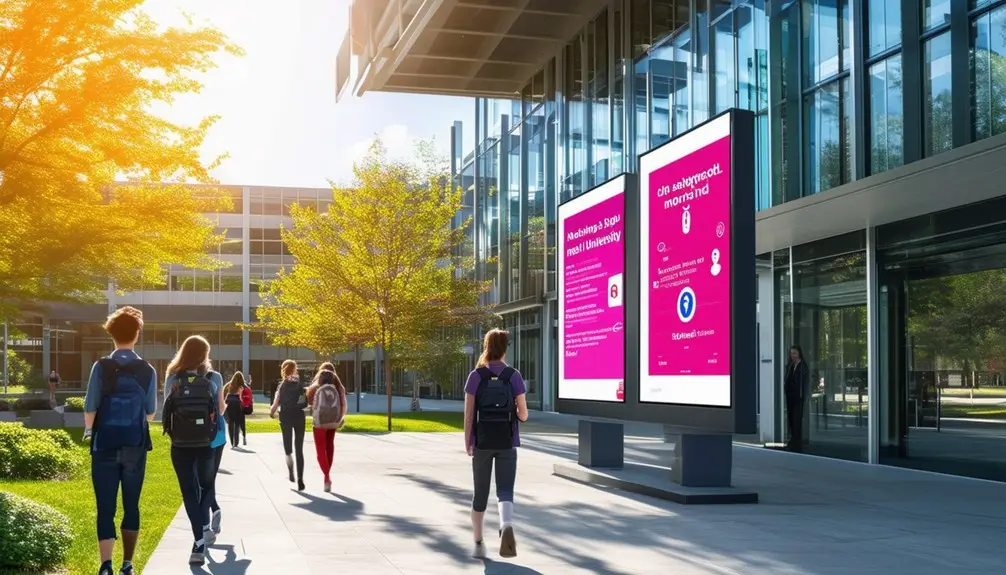For the best digital signs during campus emergencies, prioritize systems that offer immediate notifications with clear, high-definition visuals and motion graphics. These elements capture attention swiftly, guaranteeing timely responses. Centralized control allows you to manage alerts efficiently, while the integration with audio and text ensures consistent messaging. Features like interactive wayfinding can guide individuals to safety, and geo-specific messaging provides targeted alerts. Reliable digital signage should support seamless communication, making it vital for effective emergency preparedness. Enhance campus safety with tools designed for quick, accurate, and coordinated responses. Explore detailed insights on top solutions ahead.
Key Takeaways
- High-definition displays with motion graphics: Ensure messages seize attention quickly and clearly during emergencies.
- Centralized control systems: Allow for the swift deployment of emergency notifications across the entire campus.
- Integration with audio and text alerts: Guarantees consistent and comprehensive communication during critical situations.
- Geo-specific messaging capabilities: Provide targeted and relevant alerts to specific campus areas, enhancing response efficiency.
- Interactive wayfinding features: Help guide individuals to safety with clear, real-time directions during emergencies.
Importance of Digital Signage

Digital signage is necessary for campus emergency preparedness, providing instant and accurate mass notifications to everyone on campus. These digital displays guarantee that emergency messages are communicated clearly and promptly, greatly improving campus safety. During emergencies, visual elements and motion graphics on digital signs attract attention quickly, aiding in faster information processing. This immediate visual notification is critical for prompt action and safety.
Centralized control of digital displays allows you to swiftly manage and distribute emergency communications. You can instantly update messages to reflect the current situation, making sure that everyone receives consistent, up-to-date information. This capability is essential for coordinating an efficient emergency response across the campus.
Integration with audio and text alerts ensures that the emergency messages reach a broader audience. By combining visual notifications with other alert systems, you enhance the reliability and completeness of your emergency communications. This integrated approach prevents confusion and guarantees that the message is clear, regardless of how individuals receive it.
Investing in a robust digital signage infrastructure is necessary for effective campus emergency management. It enhances both safety and communication efficiency, ensuring that everyone on campus is well-informed and prepared during various emergency scenarios.
Common Emergency Scenarios
Common emergencies on campus, such as fires, active shooters, and natural disasters, demand swift and well-coordinated responses to guarantee everyone’s safety. To effectively manage these emergency scenarios, universities must implement robust emergency response plans and communication strategies. Each type of campus emergency requires specific protocols to guarantee a timely and coordinated response.
For fires, safety protocols include immediate evacuation and communication of safe routes. Active shooter scenarios demand lockdown procedures and clear communication on the shooter’s whereabouts. Natural disasters, like earthquakes or hurricanes, necessitate shelter-in-place orders and information on emergency supplies.
Training drills are essential for preparing students and staff for various emergency scenarios. Regular drills help familiarize everyone with safety protocols and improve the overall effectiveness of the emergency response. Clear communication during these drills and actual emergencies is critical for an effective response.
Universities should also invest in coordinated response systems, guaranteeing that all departments and emergency services work together seamlessly. By understanding and planning for these common campus emergencies, you can create a safer environment for everyone. Effective communication and well-practiced safety protocols are key to managing any crisis successfully.
Benefits of Digital Signage

Enhancing emergency communication on campus can be greatly improved by leveraging the benefits of digital signage. By using a digital signage notification system, you can make sure that emergency alerts are disseminated quickly and accurately. Digital signs serve as a central element in emergency communications, providing visual components in mass notifications that help people process information faster.
| Feature | Benefit |
|---|---|
| Instant Notifications | Quick and accurate emergency notifications |
| Moving HD Graphics | Grabs attention rapidly and effectively |
| Centralized Control | Streamlined emergency management |
| Integration with Audio/Text | Uniform messaging across multiple platforms |
Emergency alerts on digital signage can include moving HD graphics, which are particularly effective in grabbing attention. This visual immediacy is vital during crises. Additionally, the integration with audio and text alerts ensures that everyone receives consistent and detailed information, whether through visual, auditory, or textual means.
A well-implemented digital signage notification system can offer interactive wayfinding, guiding students and staff to safety during emergencies. Leveraging digital signage as a communication tool not only provides immediate alerts but also supports ongoing safety by being a versatile medium that integrates various forms of notifications, including text message alerts. Essentially, digital signage is an essential tool for campus safety, providing quick and reliable communication when it matters most.
Methods for Emergency Notifications

When emergency situations arise, utilizing multiple methods for notifications guarantees you’re reaching everyone quickly and effectively. Digital displays are a cornerstone for emergency notifications, guiding individuals during evacuations, relocations, shelter-in-place orders, lockdowns, and hazard identification. Leveraging AIScreen internal communication software guarantees your alerts capture attention promptly, enhancing campus safety.
Digital displays, integrated with your existing infrastructure, enable geo-specific messaging, offering widespread coverage essential for campus emergency communication. Deploying mass notifications through these signs provides real-time updates, ensuring everyone is aware of ongoing campus events and actions required.
To maximize your return on investment, use analytics and integrated plans. Track message effectiveness by identifying high-traffic areas and adjusting your strategy accordingly. This data helps you design all-inclusive emergency communication plans, ensuring your alerts are seen and acted upon swiftly.
Incorporating digital displays into your emergency communication toolkit not only speeds up the dissemination of critical information but also improves overall message effectiveness. By combining digital displays with other notification methods, you create a robust system that enhances campus safety and guarantees everyone receives timely, actionable information during emergencies.
Enhancing Communication Efficiency
How can you guarantee your emergency communication is both swift and effective? By leveraging a robust digital signage infrastructure, you can make sure that emergency alerts are displayed promptly and clearly. Use digital signs to integrate visual components with audio and text alerts, creating a complete system for efficient communication.
Centralized control is vital for managing digital displays across your campus. This allows you to quickly disseminate emergency alerts from a single point, making sure consistent messaging. Moving graphics on these displays capture attention immediately, enhancing the impact of your alerts.
Implementing an efficient communication system with digital signage involves several key steps:
- Centralized Control: Manage all signs from one location for rapid deployment of alerts.
- Integration: Combine visual, audio, and text elements to deliver all-inclusive alerts.
- Moving Graphics: Use dynamic visuals to capture attention and convey urgency.
- Consistency: Ensure messages are uniform across all platforms to avoid confusion.
- Infrastructure: Invest in reliable digital signage to support seamless emergency communication.
Conclusion
Imagine a lighthouse guiding ships through a storm. That’s what the best digital signs do for your campus during emergencies. They cut through the chaos, providing clear, reliable directions when they’re needed most. By investing in high-quality digital signage, you’re not just embracing technology; you’re safeguarding lives. Ultimately, it’s about creating a safer, more connected community, where everyone knows exactly where to turn when the unexpected happens. Make your campus a beacon of safety.
Frequently Asked Questions
How Do I Choose Digital Signage?
You should consider size, visibility, and remote access capabilities. Opt for high-resolution displays and systems that integrate with emergency notifications. Evaluate software with scheduling features for pre-planned messages to guarantee seamless communication during any situation.
What Makes Good Digital Signage?
You want good digital signage to have instant messaging, high-resolution displays, centralized control, and integration with emergency alert systems. Customizable templates and pre-set messages streamline communication, ensuring you quickly and effectively share critical information.
How Effective Are Digital Signs?
Digital signs act like a lighthouse in a storm, guiding you swiftly and clearly. They’re incredibly effective, capturing attention instantly with visuals and centralized control, ensuring quick, consistent emergency notifications that enhance safety and communication strategies.
What Are the Risks of Digital Signage?
You face several risks with digital signage, including cybersecurity vulnerabilities, data breaches, and malware attacks. Unauthorized access can lead to misinformation, while technical malfunctions and inadequate maintenance can disrupt emergency communications, rendering signs ineffective.





